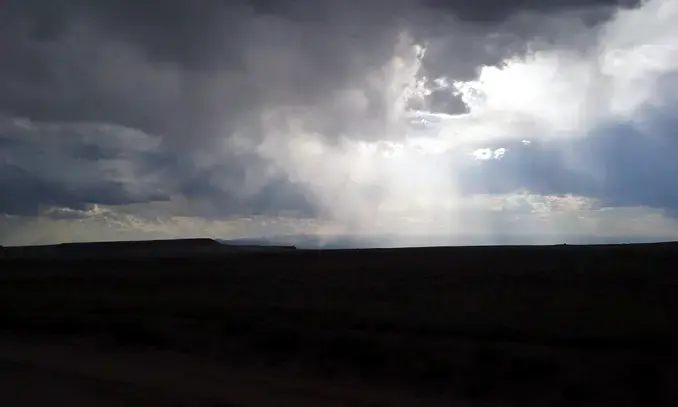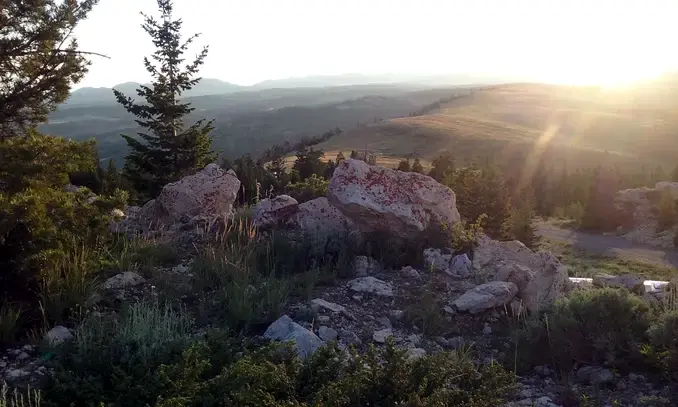Cedar Rim Opal

- Cedar Rim: Blue Tinted Opal, Translucent Chalcedony, and White Caliche
The desert is holding onto its greenery! An extra month of moisture kept me away from the rugged backcountry—I’m not a fan of getting stuck, especially with my not-so-off-road-friendly vehicle. No fun or adventure in that, and let’s be honest, I’m not exactly rolling in money.
But guess what? It’s time for a spontaneous local trip—something I can extend or scrap based on my mood and, of course, the weather.
The Game Plan
Starting off at Cedar Rim sounds perfect. I’ve been there countless times since my youth and was just there last year. On that visit, I cruised around, but this time I’m switching gears to collect fluorescent specimens on foot under the night sky.
After Cedar Rim, I’ll head east toward the Gas Hills and Rattlesnake Mountains. It’s been ages since my last visit! Finally, I’ll wrap it up by heading west to South Pass in the Wind River Mountains. What treasures await me in that small, remote, abandoned limestone quarry? Maybe some fluorescent calcite crystals?
Cedar Rim

- Every White Area at Cedar Rim Hides Opal
The temperature is pushing a warm 96°F this afternoon—perfect for gaining some altitude and escaping the heat. An hour later, I’m back on the same road my vehicle left last year, now surrounded by 18-inch deep ruts as solid as bricks. I keep my eyes on the road, carefully navigating the high ground between these ruts to avoid any SUV-bending mistakes. After all, a geologist can easily get distracted by the scenery!
The oil field road? Three lanes wide, but only one lane is barely passable. These roads seem to widen every time I’m out here, with deep ruts left by oil field trucks and mud-loving enthusiasts creating a new set of tracks. It’s a cycle of continuous erosion.
Down in South Florida, mud-loving enthusiasts pay to mud-wash their trucks, finding a mudhole and driving through until they’re coated. Windows rolled down for visibility, they only wash enough to keep it legal. It’s like a badge of manhood, right up there with truck nuts. A real novelty in a world of shiny cars, malls, and gated communities.
For me, it’s amazing how a single storm can turn a dusty road into a mud bog. Making my own deep ruts? Not my idea of a good time. Truck nuts might not do much for my girly SUV! LOL.
Up on the rim, opal lies just beneath the surface, exposed in road cuts, ruts, and washes.

- Roads Here Are Filled with Common Opal
Oil exploration and production activities also uncover opal, creating extensive dig sites. I stay clear of anything still active, but derelict places like this hold white rocks full of opal. And as a bonus, they become homes for wildlife, like an eagle’s nest on a catwalk and a sage grouse chilling in the tall sagebrush.
Sage grouse used to be abundant here in my youth, but now they’re endangered, and I hadn’t seen one in decades. It’s ironic how these creatures find sanctuary in structures left behind by the very activities that hastened their decline.

- Derelict Oil Field Activity Yielding White Opal Specimens, Scarce Desert Water, and Wildlife
Here’s some opal I found during the day. Watch out, Lightning Ridge! Could this be a new Wyoming opal hotspot? LOL

- Common Blue-Tinted Opal with Translucent Chalcedony, Manganese Dendrites, and White Caliche

- A More Transparent Opal and White Caliche
Some of it looks eerily similar to the best fluorescent opal I found a hundred miles east.

- A More Turbid Opal and Chalcedony Specimen
Do these rocks light up? A quick daylight check says yes. But are they exceptional? We won’t know until after dark.
As evening approaches, a windless 80°F feels just right. But looking southwest toward Dishpan Butte, I’m humming, “Should I stay or should I go?” Is it just a passing shower or the start of something worse?

- Just Humming, Should I Stay or Should I Go?
Plan C
That storm doesn’t look like much now, but driven by the heat in this desert, things can change quickly. Getting high-centered in a rut is not an option. It’s time to go.
This storm is building and tracking straight toward me. That path will take it toward the more remote Beaver Rim and Gas Hills areas planned as my next stop. So, I’m heading west toward South Pass instead of east. No night collecting on Cedar Rim this time, or in the Gas Hills/Rattlesnakes either.
Leaving Cedar Rim was a smart move!

- Very Nasty! Yep, Glad I’m Not in That!
South Pass
Out of the desert and into the mountains, it’s a different world—water, wildflowers, and pine forests. At 59°F, it’s hard to believe I’m just an hour away from Cedar Rim.

- What a Change!
As for the quarry? Nothing exciting in the rock department. But I did run into this guy, the biggest insect I’ve seen in Wyoming—a Mormon Cricket.

- Bet He Glows. But I’m Not About to Disturb Such a Royal Creature with My Foolishness!
Others are camped here too. Seems this quarry is a pit stop for van nomads in their 30s. They’ve got solar panels, satellite links, and are sharing their adventures—some even monetize it. Others just lay low. With my western mentality, I didn’t want to intrude, but I did a quick search for the ones I sometimes watch.
Their youthful camaraderie, lifestyle, and the scent of wood smoke from their pine campfires—such a nice change. Has it really been decades since I felt that? OMG! The memories, hopes, and dreams that fresh, resinous smoke brings back. If I were a third of my age, I’d ditch everything and join them.
Did I do something similar once? Abandoned my geologist life, moved to Alaska, got mixed up with a religious cult, married a cult member, then steered back to Wyoming, geology, and a more conventional life. I’d love to run away again—minus all the kooky religious stuff, that woman, and the decades of fallout.
Looking out from these mountains, that storm on the horizon transforms. What an adventure today has been!

- Beautiful!
It will be near freezing by morning here. Home and my cozy bed are just over an hour away. Humming, “I’m on my way home.” I’m gone.
Descending, the twilight basin is now cooler and very comfortable at 80°F. Freshly cut alfalfa perfumes the air. A new moon dimly illuminates the complex rocky outcrops, engaging my imagination. It’s a delightful night and an appropriate end to this Cedar Rim adventure.
One Thing Remaining - The Fluorescence
The daylight specimens are piled next to similar-looking material found a hundred miles east.
With large, well-formed manganese dendrites, more translucency, various tints, and well-defined opal boundaries, Cedar Rim material makes for great daylight specimens. A third of what I collected during the day is beautifully fluorescent—brighter under long wave than the other opal I’ve found. It lacks the yellow and pastel fluorescence in midwave ultraviolet, but short wave ignites brilliant greens and rare bright white-blue silicate crack filling/blebs. Very nice!
Under multiwave, Cedar Rim opal really pops with large, brilliant patches of yellow-green fluorescence. It’s only seen as small specks and narrow crack fillings in the other material. And it’s the same stuff that makes up the opal pie specimen.
I’m still searching for the source of that pie specimen. It’s the brightest fluorescent specimen I’ve ever seen, fueling my lifelong opal search.
I’ve seen hints of it as specks and thin crack fillings, but I’ve never encountered it in big chunks or thick seams like the opal pie specimen. The opal pie isn’t as dramatic as the multi-colored fluorescent opal I’ve found since, but it mutes them with overwhelming bright intensity.
All this opal formed in similar conditions, at about the same time, and in the same formation. But, like all things fluorescent, location is everything. Cedar Rim is vast, and I’m convinced some really good fluorescent material exists there. I’ll keep looking!
I’d planned to get a fluorescent image of the chalcedony and blue-tinted opal specimen shown above, but I couldn’t find it anywhere at home! Apparently, it fell out of my daypack as I wandered around. So, no fluorescent image from my makeshift darkroom. I promise I’ll do better when winter keeps me cooped up at home. ✨
Update
Here are some images of Cedar Rim glow. Like all fluorescence images, they really can’t compete with what a dark-adjusted eye sees.

- Cedar Rim Specimens in Natural Light

- Cedar Rim Specimens in Long Wave Ultraviolet Light

- Cedar Rim Specimens in Mid Wave Ultraviolet Light

- Cedar Rim Specimens in Short Wave Ultraviolet Light
Cheers, D 🪨🔥
